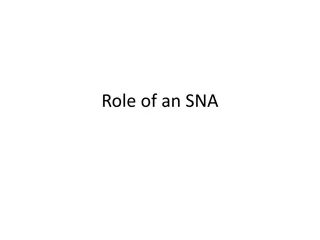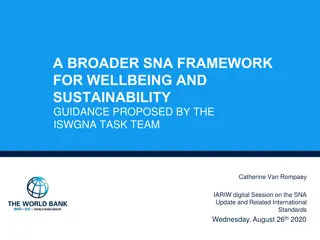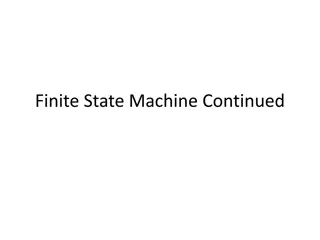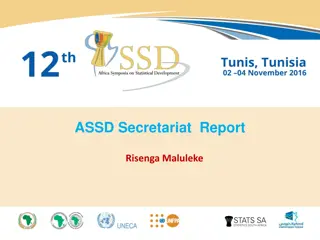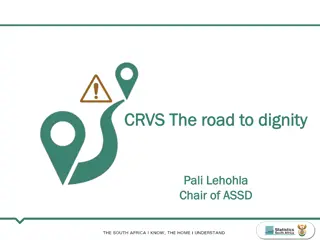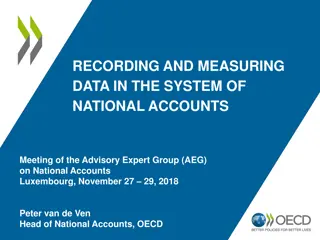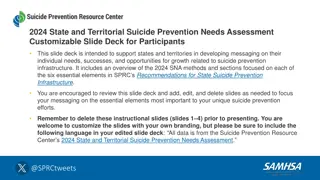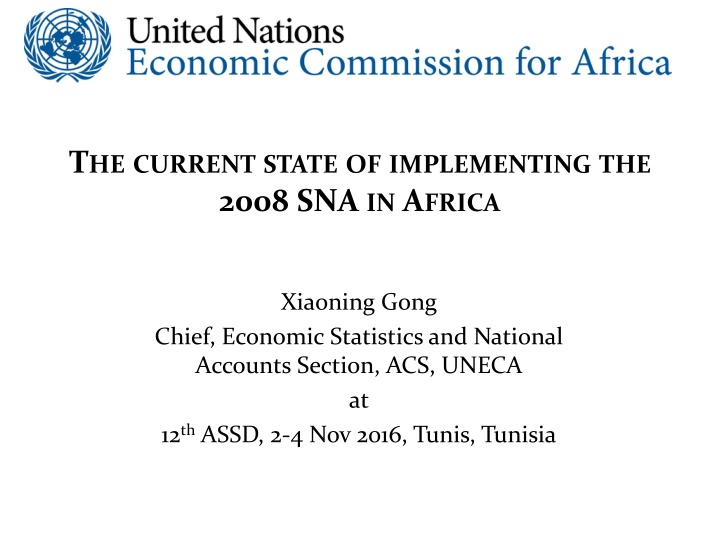
Implementing the 2008 SNA in Africa: Current Status and Challenges
Explore the progress and obstacles in implementing the 2008 System of National Accounts (SNA) in Africa, as discussed in a presentation by Xiaoning Gong. The presentation covers objectives, stakeholders, issues, governance, and the scope of national accounts activities. Additionally, it details various versions of SNA and classifications used in different African countries, along with base years for calculating Constant GDP.
Download Presentation

Please find below an Image/Link to download the presentation.
The content on the website is provided AS IS for your information and personal use only. It may not be sold, licensed, or shared on other websites without obtaining consent from the author. If you encounter any issues during the download, it is possible that the publisher has removed the file from their server.
You are allowed to download the files provided on this website for personal or commercial use, subject to the condition that they are used lawfully. All files are the property of their respective owners.
The content on the website is provided AS IS for your information and personal use only. It may not be sold, licensed, or shared on other websites without obtaining consent from the author.
E N D
Presentation Transcript
THECURRENTSTATEOFIMPLEMENTINGTHE 2008 SNA IN AFRICA Xiaoning Gong Chief, Economic Statistics and National Accounts Section, ACS, UNECA at 12thASSD, 2-4 Nov 2016, Tunis, Tunisia
Outline of the Presentation Overview of the Project Challenges Objectives of the project Players and stakeholders Problems and issues to be addressed by the Project Scheme and architecture of the African Project on SNA Three stages and expected accomplishments Governance structure of the project Implementation strategy Current status Economic Commission for Africa www.uneca.org
Different Versions of SNA Used SNA in use Number of Countries % share 2008 SNA 10 20.8 1993 SNA 36 75 1968 SNA 2 4.2 Total 48 100
Different Versions of Classification Used Classification of Activity Currently Used ISIC Rev 3 7 ISIC Rev 3.1 6 ISIC Rev 4 16 NAEMA 10 NAEMA rev1 5 Other 4
Scope of National Accounts Activities Currently compiling % SNA 2008 compliance for production and asset boundaries IT tool for compilation of national accounts Employment matrix Supply and use table (SUT) Production approach GDP by industrial economic activities: Production approach GDP-- by institutions Expenditure approach GDP Quarterly GDP Production and generation of income accounts 17 35% 25 52% 11 25 23% 52% 34 71% 20 42% 36 16 75% 33% 23 48% Sector accounts up to capital account 18 38% Sector accounts up to financial accounts 5 10% Balance sheets 1 2%
Base-year for Constant GDP Countries Base Year 2011/12 Sao Tome and Principe 2011 Benin 2011 Cape Verde 2010 Comoros 2010 Madagascar 2010 Mauritus 2010 Morocco 2010 Tanzania, United Republic of 2010-11 Togo 2009/10 Botswana 2009 Ghana 2009 Niger 2009 Seychelles Countries Base Year 2008 2007 2007 2007 2007 2007 2007 2007 2007 2006 2006 2006 2006 Egypt South Sudan Swaziland Liberia Malawi Nigeria South Africa Zambia Ethiopia Uganda Djibouti Mozambique Zimbabwe
Base-year for Constant GDP (Contd) Countries Base Year 2006 2005 2005 2005 2005 2005 2005 2004 2004 2004 2001 2001 1999 1999 Countries Base Year 1997 1997 1996 1981/82 Sierra Leone Burundi Cameroon Chad Congo Democratic Republic of Congo Guinea-Bissau Gambia Lesotho Mauritania Algeria Gabon Burkina Faso Senegal Mali Tunisia C te d'Ivoire Sudan
Problems and Issues to Be Addressed Limited Human, Financial, and Technical Resources Weak Capacity and Statistical Infrastructure Unharmonious National Accounts Systems Inconsistency and Incompleteness in the Coverage of the Economy Early Stages in the Development of National Accounts For more info . . . List location or contact for specification (or other related documents) Economic Commission for Africa www.uneca.org
developed by the African Group on National Accounts under the umbrella of the Statistical Commission for Africa The African Strategy for the Implementation of the 2008 SNA Objective Implementation of 2008 SNA in all African countries Aim overcome statistical weaknesses by brining together all African countries to work together to implement SNA 2008 Economic Commission for Africa www.uneca.org
United Nations Economic Commission for Africa African Union Commission Major roll players African Group on National Accounts African Development Bank Economic Commission for Africa www.uneca.org
Collaboration & Support to Member States ECA AUC AfDB MS RECs Afristat Secretariat Economic Commission for Africa www.uneca.org
Governance Structure of the African Project Meetings of the Heads of AUC, AfDB and UNECA Annual Progress Report Continental Steering Committee (CSC) Governance Annual Progress Report Executive Board (UNECA, AUC, AfDB) Statistical Commission for Africa (StatCom-Africa) / Committee of Directors General (CoDG) CSC Secretariat (at UNECA) Implementation African Group on National Accounts (AGNA) Pan-African Institutions, Member States, AFRISTAT, Regional Economic Communities National Statistical Systems National Strategy Coordinators, National Statistics Offices and Others Economic Commission for Africa www.uneca.org
Project Design and Interventions Problems / Issues to Be Addressed Limited Human, Financial, and Technical Resources Project Design and Interventions Continental project approach for all the countries to work together Advocacy and NSDS to mobilize resources for national statistical system Building human and technical capacity Strengthen the statistical institution and infrastructure Weak Capacity and Statistical Infrastructure Unharmonious National Accounts Systems in the Continent The new SNA system, i.e. the 2008 SNA provides an opportunity to harmonize the national accounting systems in African countries Informal sector Exhaustiveness SUT and commodity flow approach Integrate national accounts statistics with other sectoral statistics Phased approach in the implementation of the 2008 SNA Inconsistencies and Incompleteness in the Covering of the Economy Early Stages in the Development of Economic Commission for Africa www.uneca.org National Accounts
Architecture of African Project on SNA Implementation of SNA 2008 Country Plans and Actions Advocacy Campaign Compiling Technical Capacity Building Strengthening Institutional Documents Coordination, Monitoring, Evaluation, and Reporting
Pillar 1: Country plans and actions Allows member states to align 2008 SNA with African statistical strategies and macroeconomic priorities Pillar 2: Technical assistance (AfDB) Strengthen statistical institutions and the capacity of national statistics systems Adopt IT tools, conduct seminars and training workshops Pillar 3: Institutional strengthening (Afristat) Develop and strengthen coordination structures and systems Economic Commission for Africa www.uneca.org
Pillar 4: Technical documents (ECA) Serve as operational guides for the compilation of national accounts Development of a guidebook and handbook Pillar 5: Advocacy campaign (AUC) Organized at a continental, regional and national levels Pillar 6: Coordination, monitoring, evaluation and reporting Close monitoring of the project implementation plan Production and dissemination of monitoring and evaluation reports Economic Commission for Africa www.uneca.org
Expected Accomplishments & Outputs Output 1.1: Application of modern IT tools for compiling, processing, and analyzing statistical information Output 1.2: Establishment and strengthening of needed institutions Output 2.1: Availability of technical document on use of administrative data for national accounts compilation Output 2.2: Availability of financial resources for national accounts activities Output 3.1: SNA Continental Steering Committee and Secretariat established and functional Output 3.2: Monitoring, evaluation, and reporting developed and related results produced Economic Commission for Africa www.uneca.org
Architecture of African Project on SNA Implementation of SNA 2008 Country Plans and Actions Advocacy Campaign Compiling Technical Capacity Building Strengthening Institutional Documents Coordination, Monitoring, Evaluation, and Reporting
Country Plans and Actions: Led by Member States Country Plans and Actions I. Country Plans and Actions Activity 0.1: Formulate country implementation plan for the 2008 SNA Activity 0.2: Take follow-up actions to change over to the 2008 SNA Activity 0.3: Collaborate with AGNA Members and Development partners to fill in the gaps Member States Member States Member States Economic Commission for Africa www.uneca.org
Status of National Action Plans Up to May 2016, among the 48 countries that responded to the questionnaire: 32 countries reported that they have formulated national actions plans for implementing the 2008 SNA. 10 countries reported that they are currently in the process of formulating national action plans. The 10 countries are: Angola, Botswana, Ghana, Lesotho, Malawi, Mozambique, Swaziland, Uganda, Togo, and Zambia. 5 countries reported having no action plan and have expressed their need for technical assistance to develop their action plans. The 5 countries are: Central African Republic, Chad, Comoros, Equatorial Guinea and Liberia. Economic Commission for Africa www.uneca.org
Planned Year for Adopting the 2008 SNA Planned year Number of Countries % share 2010-15 9 19.1 2016 9 19.1 2017 12 25.5 2018 8 17 2020 + 2 4.3 Not decided 8 14.9 Total 48 100
Basic Economic Statistics for SNA Currently Implementing Will be implementing Data sources Included in action plan Administrative data Census Population Census Agriculture Census Livestock Census Other Census Household surveys 19 29 11 13 12 12 3 15 26 15 11 10 30 13 16 18 1 13 Informal sector survey 11 16 24 Establishment and/or enterprise Survey 16 22 18 Other sources 8 5 4
Capacity Building: Led by AfDB Capacity Building Capacity Building II. Capacity Building (AfDB) Activity 1.1.1: Support to adopt and apply IT tools AUC, AFRISTAT, ECA, RECs, Member States AfDB, AFRISTAT, RECs Activity 1.1.2: Technical assistance for countries Economic Commission for Africa www.uneca.org
Institutional Strengthening: Led by RECs & Afristat Strengthening Institutional III. Institutional strengthening (RECs & Afristat) Activity 1.2.1: Strengthen existing governance and coordination structures at national level. Activity 1.2.2: Create the African Network of National Accountants (ANNA). RECs, Member States AfDB, Member States Economic Commission for Africa www.uneca.org
Training Needs Domains Number of Countries % Concepts, definitions, and classifications of 2008 SNA 27 56% Collection and processing of sources data 24 50% Use of IT tools for the compilation of national accounts SNA 2008 compliance -- for production and asset boundaries Employment matrix 29 60% 31 65% 35 73% Supply and use table (SUT) 29 60% Quarterly GDP 28 58% Production accounts 25 52% Distribution and redistribution of incomes accounts 29 60% Capital account 31 65% Financial account 32 67% Balance sheets 32 67% Analysis of national accounts results 33 69%
Technical Assistance Needs Domains Number of Countries % Concepts, definitions, and classifications of 2008 SNA Collection and processing of sources data Use of IT tools for the compilation of national accounts SNA 2008 compliance -- for production and asset boundaries Employment matrix Supply and use table (SUT) Quarterly GDP Production accounts Distribution and redistribution of incomes accounts Capital account Financial account Balance sheets Analysis of national accounts results Other areas 21 21 26 44% 44% 54% 26 54% 25 21 24 17 25 22 24 22 26 12 52% 44% 50% 35% 52% 46% 50% 46% 54% 25%
Advocacy Campaign: Led by AUC Advocacy Campaign IV. Advocacy campaign (AUC) Activity 2.2.1: Prepare advocacy materials and tools. Secretariat Activity 2.2.2: Organize advocacy campaigns AUC, RECs, Member States Economic Commission for Africa www.uneca.org
Compiling Technical Documents: Led by ECA Compiling Technical Documents V. Compiling technical documents (ECA) Activity 2.1.1: Make an inventory RECs, AFRISTAT, Member States, ECA ECA, AFRISTAT Activity 2.1.2: Develop a guidebook Economic Commission for Africa www.uneca.org
Coordination, Monitoring, Evaluation, and Reporting: Led by Secretariat Coordination, Monitoring, Evaluation, and Reporting VI. Monitoring, evaluation, and reporting (Secretariat) Activity 3.2.1: Conduct a further and in-depth assessment Activity 3.2.2: Develop framework and tools for monitoring, evaluation, and reporting Activity 3.2.3: Produce and disseminate monitoring and evaluation reports. Secretariat, RECs, AFRISTAT, Member States Secretariat, RECs, Member States Secretariat, RECs, Member States Economic Commission for Africa www.uneca.org
Demand-Supply Matrix for CB.docx
Current Status Progress: Continental Steering Committee established Secretariat operationalized Agreed Project Implementation Plan (PIP) Challenge: Funds to support the operations & activities Economic Commission for Africa www.uneca.org
Thank you for your attention!


